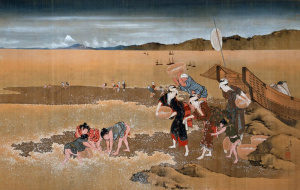
“Collecting Shells at Low Tide”, by Hokusai, Japan, c. 1832-1834. Colour on silk. Osaka Municipal Art Museum, Osaka. Source: http://www.nippon.com/en/currents/d00021/
Women’s as well as men’s fishing should be taken into account in marine ecology assessments, according to the recent global review, “Gender and small-scale fisheries: a case for counting women and beyond“, by Danika Kleiber, Leila Harris and Amanda Vincent. Typically, they point out, women’s participation is only considered from a social perspective.
After reviewing 106 case studies reported over the last 20 years (including many reported in the AFS Gender in Aquaculture and Fisheries symposia), they examine why women may not be included in fishing accounts. They conclude that the very definition of fishing and fishers can be a limitation (see also their paper on fishing in the Central Philippines). Also, gender may be overlooked as a key variable in the study design and thus the sampling becomes biased. Finally, gender data can “evaporate” as a study is conducted, even if included in the design from the start, for example if the field data collectors are not trained in collecting gendered data.
The paper ends with this statement:
The inclusion of gender enables us to more accurately assess the state of fisheries, to better understand the diverse effects of fisheries change and management for populations, and to move towards the interdisciplinary management models that are increasingly demanded by policy makers.
To contact Danika Kleiber: Danika.Kleiber@gmail.com
Abstract: Marine ecosystem–scale fisheries research and management must include the fishing effort of women and men. Even with growing recognition that women do fish, there remains an imperative to engage in more meaningful and relevant gender analysis to improve socio-ecological approaches to fisheries research and management. The implications of a gender approach to fisheries have been explored in social approaches to fisheries, but the relevance of gender analysis for ecological understandings has yet to be fully elaborated. To examine the importance of gender to the understanding of marine ecology, we identified 106 case studies of small-scale fisheries from the last 20 years that detail the participation of women in fishing (data on women fishers being the most common limiting factor to gender analysis). We found that beyond gender difference in fishing practices throughout the world, the literature reveals a quantitative data gap in the characterization of gender in small-scale fisheries. The descriptive details of women’s often distinct fishing practices nonetheless provide important ecological information with implications for understanding the human role in marine ecosystems. Finally, we examined why the data gap on women’s fishing practices has persisted, detailing several ways in which commonly used research methods may perpetuate biased sampling that overlooks women’s fishing. This review sheds light on a new aspect of the application of gender research to fisheries research, with an emphasis on ecological understanding within a broader context of interdisciplinary approaches.
This entry was posted in: Freshwater Fisheries, Gender, Marine Fisheries, Men, Women
